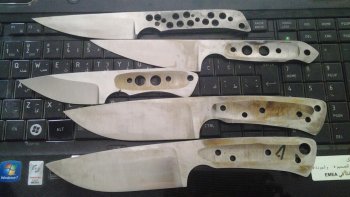SHOKR
Well-Known Member
How do you guys go about finishing the knife?
I know after HT i clean tang and grind bevel, attach handle, shape it then do the profile.(btw what grit do you finish the profile with? Same as blade?)
Some parts however i dont know where to fit into all that.
Ex: after shaping the handle i hand sand it to round the sharp edges with 120 or 220 grit (i have no slack, the only slack is above the top wheel of platen and that just throws dust in my face), this puts scratches on the profile (altho now that i think about it maybe the better sequence would be to finish shaping then profile last)
Another one is the lower part of the ricasso (between handle and pkunge cut)
And im guessing there are other things im not yet aware of...
So can anybody give me details of how they go about finalizing the knife?
Thanks
I know after HT i clean tang and grind bevel, attach handle, shape it then do the profile.(btw what grit do you finish the profile with? Same as blade?)
Some parts however i dont know where to fit into all that.
Ex: after shaping the handle i hand sand it to round the sharp edges with 120 or 220 grit (i have no slack, the only slack is above the top wheel of platen and that just throws dust in my face), this puts scratches on the profile (altho now that i think about it maybe the better sequence would be to finish shaping then profile last)
Another one is the lower part of the ricasso (between handle and pkunge cut)
And im guessing there are other things im not yet aware of...
So can anybody give me details of how they go about finalizing the knife?
Thanks

